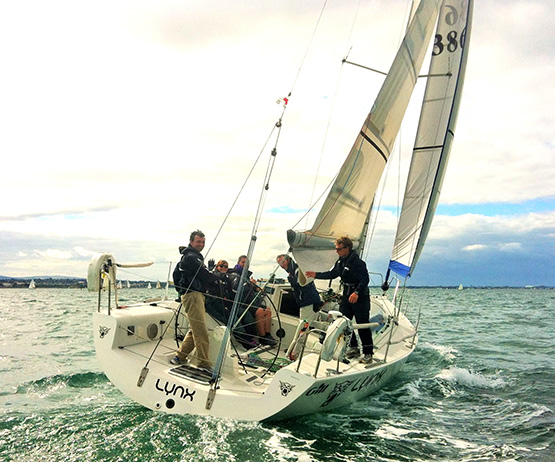Anyone feeling a bit despondent about the future of Irish sailing, what with the disappointing weather for periods of the 2015 season, plus the lack of some really high profile international racing successes, would have had their sprits lifted mightily – and then some – by being around the Irish National Sailing School in Dun Laoghaire last weekend writes W M Nixon
This remarkable organisation, whose background and lively ongoing story we profiled on Afloat.ie on 16th May, have seen their records of numbers participating raised again and again through the summer as the numbers of trainees – from absolute beginners right up to wannabe offshore crews in the school’s Reflex 38 Lynx - have steadily increased, until a new peak was reached last Saturday when absolutely every boat in the club’s large and varied fleet was in constant action, with new participant levels achieved.
Other organisations in the sailing school sector used to wonder in admiration after the INSS began to get regular turnouts of more than 150 schoolchildren per day – when we were visiting on Monday May 10th, 185 schoolkids had been bussed down from Maynooth and were having the time of their lives afloat, many for the very first time.
Nevertheless, while 185 or even 190 participants in the INSS’s schoolchildren division were fairly frequent occurrences, it wasn’t until last Saturday - a great and golden day whatever the weather - that they finally surpassed the 200 mark for members of their Junior Club - aged 7 and over – afloat and learning how best to enjoy the wonders of boats and sailing.
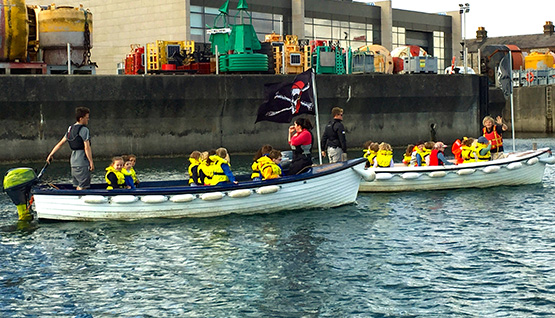 You get them into sailing in gentle stages. With toddlers and infants, just going out on a boat with a feeling of safety is a good first stage – this is Muriel Rumball (lead boat) with the most junior class – some of their parents may themselves be afloat with the INSS learning to sail in larger craft.
You get them into sailing in gentle stages. With toddlers and infants, just going out on a boat with a feeling of safety is a good first stage – this is Muriel Rumball (lead boat) with the most junior class – some of their parents may themselves be afloat with the INSS learning to sail in larger craft.
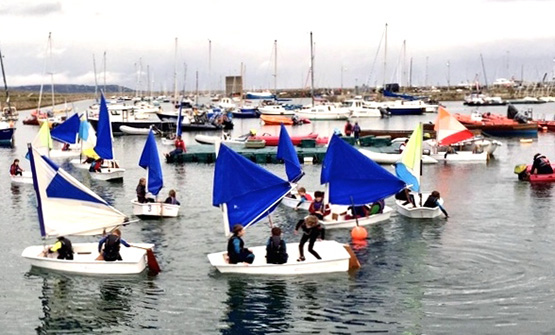 The first stages in sailing should be more about manageability than technical tuning – an Optimist with its sprit out of use lends itself well to fun afloat while gently familiarising the kids with the basics of sailing and getting on with others in the confines of a boat.
The first stages in sailing should be more about manageability than technical tuning – an Optimist with its sprit out of use lends itself well to fun afloat while gently familiarising the kids with the basics of sailing and getting on with others in the confines of a boat.
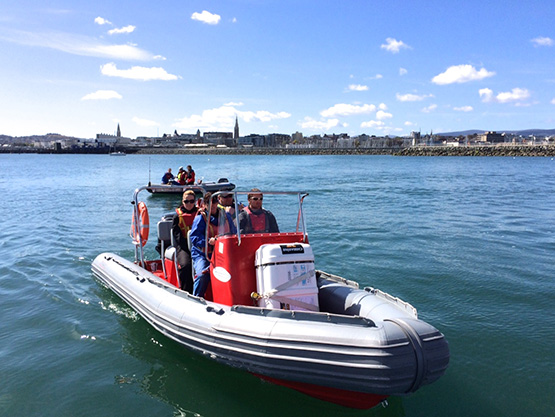 The powerful RIB Sting could be a lethal weapon in the wrong hands, but as she is one of the boats in the INSS Powerboat Course, her competent use is a feature of the school’s activities.
The powerful RIB Sting could be a lethal weapon in the wrong hands, but as she is one of the boats in the INSS Powerboat Course, her competent use is a feature of the school’s activities.
But that was only the start of it, for the school’s popular National Powerboat Course was running for the whole weekend with full turnouts, while the rest of the Schools’ sailing fleet, including 1720s and the Reflex 38 offshore racer, had more than 30 out in adult beginner training courses.
In our report of May 15th, we particularly remembered being in at the beginning of the historic first committee meeting of the newest club in Ireland, the Irish National Sailing Club, which enables the Sailing School alumni to take part in official regattas anywhere, and other open events, for the princely annual subscription of €10.
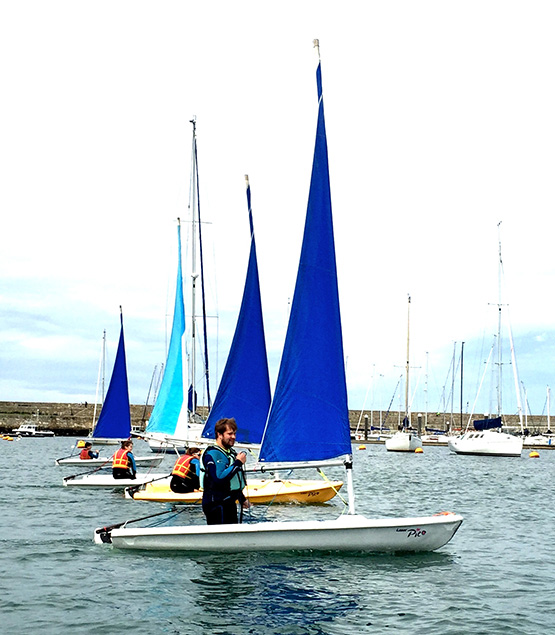 The highly durable Pico is one of the key boats in the INSS’s intermediate courses
The highly durable Pico is one of the key boats in the INSS’s intermediate courses
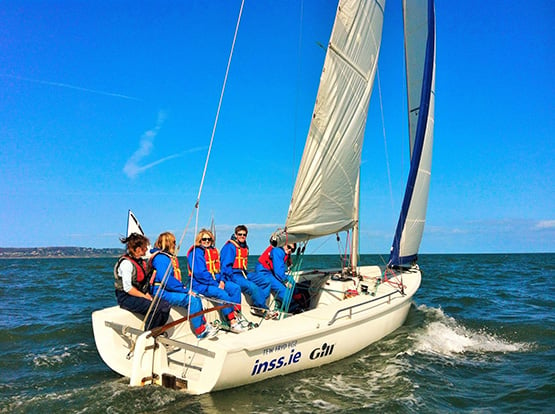 When Tony Castro designed the 1720 Sportboat for a group of Cork Harbour performance enthusiasts back in 1994, he can scarcely have imagined that twenty-one years later a couple of them would be providing ideal training craft for a busy sailing school in Dun Laoghaire
When Tony Castro designed the 1720 Sportboat for a group of Cork Harbour performance enthusiasts back in 1994, he can scarcely have imagined that twenty-one years later a couple of them would be providing ideal training craft for a busy sailing school in Dun Laoghaire
But so worthwhile has the growth and development of the INSC been during 2015 that its members have mustered sufficient numbers to stage their own proper races, and this line of progress also reached a new level on Saturday with the club staging the first INSC Mini-Regatta, with racing for its dinghy classes and well-used Squib fleet.
The regatta even had celebrity participation with noted former international athlete, Senator Eamonn Coughlan, taking part to film part of a documentary called Super Fit Seniors, recording the rapidly improving performance afloat of an 83-year-old whose name we’ve promised not to reveal until the programme is due to be broadcast, but we are allowed to say that if the national policy declares that “Sailing is a Sport for Life”, then on Saturday the INSS was proving it in abundance.
 First committee meeting of the Irish National Sailing Club on Monday May 10th 2015. The committee and school management of the newly-formed Club are (left to right) Glyn Williams (foreground), Muriel Rumball, Joan Sheffield, Caroline Herron, Robin Jones, Alistair Rumball, Kenneth Rumball, Garrett O'Malley, Dermot Igoe, Heather Blay and Mary Beck. Photo: W M Nixon
First committee meeting of the Irish National Sailing Club on Monday May 10th 2015. The committee and school management of the newly-formed Club are (left to right) Glyn Williams (foreground), Muriel Rumball, Joan Sheffield, Caroline Herron, Robin Jones, Alistair Rumball, Kenneth Rumball, Garrett O'Malley, Dermot Igoe, Heather Blay and Mary Beck. Photo: W M Nixon
Such is the stature of the Irish National Sailing School that it has been selected as the venue for one of the key assemblies in the up-coming series of Irish Sailing Association Regional Cluster Development Meetings, which seek to improve inter-club relationships and facilitate regional co-operation for the mutual benefit of the many and varied club memberships in specific areas.
The ISA East and Southeast Regional Development Officer Sarah-Louise Rossiter will be holding the meeting for sailing and yacht clubs in the Dublin South Cluster in the Irish National Sailing School from 7.0pm to 9.0pm on Wednesday October 7th.
We can only hope that some of the stardust now exuding from the INSS will waft on to those from other clubs. Alistair Rumball, founder of the INSS way back in 1974, helpfully explains how it’s done: “There’s nothing special to it. You just have to have everyone prepared to work 15 hours a day seven days a week, and be mad keen about teaching and sailing. That’s all it is. Simple as that really”.
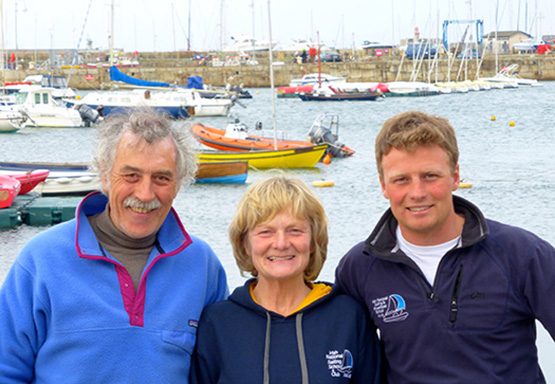
The National Sailing School’s Alistair and Muriel Rumball and their son Kenneth. “You just have to have everyone prepared to work 15 hours a day seven days a week, and be mad keen about teaching and sailing. That’s all it is. Simple as that really”.


























